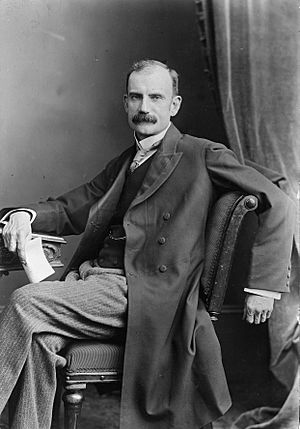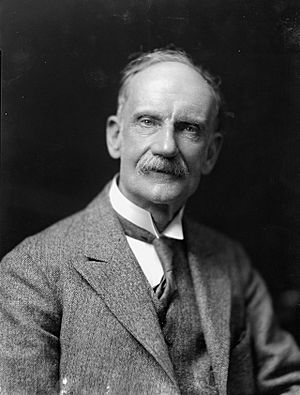William Pember Reeves facts for kids
Quick facts for kids
William Pember Reeves
|
|||||||||||||||||||||||||||||||
|---|---|---|---|---|---|---|---|---|---|---|---|---|---|---|---|---|---|---|---|---|---|---|---|---|---|---|---|---|---|---|---|

Portrait of William Pember Reeves possibly taken when he was elected to be a member of parliament in 1887
|
|||||||||||||||||||||||||||||||
| 5th High Commissioner to the United Kingdom | |||||||||||||||||||||||||||||||
| In office December 1896 – December 1908 |
|||||||||||||||||||||||||||||||
| Monarch | Victoria Edward VII |
||||||||||||||||||||||||||||||
| Prime Minister | Richard Seddon | ||||||||||||||||||||||||||||||
| Preceded by | Westby Perceval | ||||||||||||||||||||||||||||||
| Succeeded by | William Hall-Jones | ||||||||||||||||||||||||||||||
| 1st Minister of Labour | |||||||||||||||||||||||||||||||
| In office 31 May 1892 – 10 January 1896 |
|||||||||||||||||||||||||||||||
| Prime Minister | John Ballance Richard Seddon |
||||||||||||||||||||||||||||||
| Succeeded by | Richard Seddon | ||||||||||||||||||||||||||||||
| 9th Minister of Education | |||||||||||||||||||||||||||||||
| In office 24 January 1891 – 10 January 1896 |
|||||||||||||||||||||||||||||||
| Prime Minister | John Ballance Richard Seddon |
||||||||||||||||||||||||||||||
| Preceded by | Thomas William Hislop | ||||||||||||||||||||||||||||||
| Succeeded by | William Campbell Walker | ||||||||||||||||||||||||||||||
| Member of the New Zealand Parliament for City of Christchurch |
|||||||||||||||||||||||||||||||
| In office 5 December 1890 – 13 February 1896 |
|||||||||||||||||||||||||||||||
| Preceded by | Constituency recreated | ||||||||||||||||||||||||||||||
| Succeeded by | Charles Lewis | ||||||||||||||||||||||||||||||
| Member of the New Zealand Parliament for St Albans |
|||||||||||||||||||||||||||||||
| In office 26 September 1887 – 5 December 1890 |
|||||||||||||||||||||||||||||||
| Preceded by | Francis James Garrick | ||||||||||||||||||||||||||||||
| Succeeded by | Constituency abolished | ||||||||||||||||||||||||||||||
| Personal details | |||||||||||||||||||||||||||||||
| Born | 10 February 1857 Lyttelton, New Zealand |
||||||||||||||||||||||||||||||
| Died | 16 May 1932 (aged 75) London, England |
||||||||||||||||||||||||||||||
| Political party | Liberal | ||||||||||||||||||||||||||||||
| Spouse | Magdalen Stuart Robison | ||||||||||||||||||||||||||||||
| Children | 3, including Amber Reeves | ||||||||||||||||||||||||||||||
| Parents | William Reeves (father) Ellen Pember (mother) |
||||||||||||||||||||||||||||||
| Occupation | Lawyer and journalist | ||||||||||||||||||||||||||||||
|
|||||||||||||||||||||||||||||||
William Pember Reeves (born February 10, 1857 – died May 16, 1932) was an important person in New Zealand's history. He was a politician, a cricketer, a historian, and a poet. He is best known for helping to bring about many social changes in New Zealand.
Contents
Early Life and Education
William Pember Reeves was born in Lyttelton, New Zealand. His parents, William and Ellen Reeves, had moved there from Britain just before he was born in 1857. His father was also a journalist and a politician.
William went to school in Christchurch. He attended a private prep school, the local high school, and then Christ's College Grammar School until 1874. Before he became a politician, he worked as a lawyer. He was also a journalist and edited newspapers like the Canterbury Times and the Lyttelton Times.
Cricket Star
William Pember Reeves was also a talented cricketer. He played in five top-level cricket matches for the Canterbury team between 1879 and 1888. He was a batsman, which means he was good at hitting the ball. His best score was 54 runs in a match where Canterbury beat another team, Otago, by just four runs in 1883.
Becoming a Politician
Reeves became a Member of Parliament in 1887. He first represented the area of St Albans until 1890. Then, from 1890 to 1896, he represented the area of Christchurch. He was a member of the Liberal Party.
During his time in Parliament, he held several important jobs. He was the Minister of Labour from 1892 to 1896. This role meant he was in charge of laws and policies about workers. He was also the Minister of Education from 1891 to 1896, looking after schools and learning. He also served as Minister of Justice for some time.
Making a Difference in New Zealand
As Minister of Labour, Reeves introduced a very important law called the Industrial Conciliation and Arbitration Act 1894. This law helped to settle disagreements between workers and their employers. It was a big step towards fairer working conditions in New Zealand.
He also tried to pass a law called the Undesirable Immigrants Exclusion Bill. This bill would have stopped poor people and people from Asia from moving to New Zealand. This idea was not popular with everyone, and some people even called him "Undesirable Bill" Reeves because of it.
Life in London
In 1896, Reeves left New Zealand and moved to London, England. He became the Agent General for New Zealand in London, and later the High Commissioner. These roles meant he represented New Zealand's interests in the United Kingdom. He held these positions until 1908.
While in Britain, Reeves became friends with many famous thinkers and writers. These included people like George Bernard Shaw and H. G. Wells, who were part of a group called the Fabian Society. This group worked to improve society through gradual changes.
After his time as High Commissioner, Reeves became the Director of the London School of Economics from 1908 to 1919. This is a very famous university. He also led a committee that organized the first Universal Races Congress in London in 1911, which aimed to promote understanding between different races. From 1917 to 1931, he was the chairman of the board for the National Bank of New Zealand.
Reeves was also a writer. He wrote a history book about New Zealand called The Long White Cloud (1898). He also wrote another book, State Experiments in Australia and New Zealand (1902), and several poems.
Family Life
William Pember Reeves married Magdalen Stuart Robison in 1885. She was a feminist, which means she believed in equal rights for women. They had three children: two daughters, Amber and Beryl, and one son, Fabian. Sadly, their son Fabian died in the First World War when he was only 21 years old.
Reeves was offered a knighthood three times, but he always said no. A knighthood is a special honor given by the British monarch.
Works
- State Experiments in Australia & New Zealand. London: Grant Richards. 1902.
See also
- List of Canterbury representative cricketers


